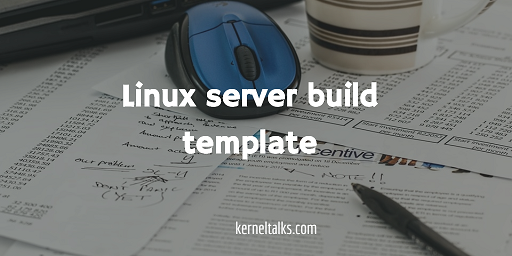Linux server build template which will help you design your own build sheet or build book. This template can be used as a baseline and has all the necessary details regarding the new server build.

Technical work needs to be documented well so that it can be referred by future sysadmins and make their life easy! One of the important documentation all Linux sysadmin has to maintain is the Server build book or server configuration sheet.
Although there are many automation tools available in the market which serve the purpose of pulling configuration from the server and presenting you in a formatted manner, they come into the picture once the server is up and running. What if you want to fill in this server build document before the server is made active. Or you need to draft a server build sheet wherein you require the requester to fill in details so that accordingly you will deploy the server. In such cases you can not rely on automation tools.
Before you read further please be noted that this is a pure process-related document being discussed not the technical.
It will be a manual method of collecting information from respective stakeholders and then using all information, you can build your server. Information collection can be done from various stakeholders like below –
- Business authorities (project details, billing context, server tier classification)
- Datacenter team (hardware details)
- Storage team (Storage connectivity and capacity)
- Network team (IP, connectivity matrix)
For building or deploying one Linux server, all the above-said stakeholders needs to be contacted to get relevant information which will help to deploy a server. I have created on sample template for Linux server build which you may refer (link at end of the article).
Business authorities can help you identify the server’s tier classification. It tells you how critical the server it is. Most critical servers will get high-performance resources (like SSD storage), latest tech while less critical receives less expensive resources (like SATA disk storage). This tier configuration mostly named under platinum (being most critical, high valued), gold, silver, copper (being least critical). The terminology may change in different organizations but this is widely used across the IT industry. Business authorities also help you identify server’s project so that you can use this information in your Inventory sheet or naming conventions for server infra etc.
Datacenter team helps you to identify hardware on which you can build your server. If its a physical server then its DC location along with Rack number, chassis number, blade number, etc details helps you in locating the server physically. Also iLO or management port connectivity can be arranged with the help of the data center team. This is crucial for a new server when they don’t have anything running on them and you have to start afresh install. If it’s a virtual server based on virtualization like VMware, the datacenter team can help you identify proper hosts within virtualized infra to host your server. Other details like VMware datacenter, cluster, ESXi host, datastore can be obtained with the help of the DC team.
The storage team can help you with LUN provisioning according to your requirement. Storage can be allocated according to the server tier. If its a new physical server then you need to have physical connectivity as well in place with the help of storage and DC team.
The network team can provide you with free IP, subnet mask, and gateways which are to be configured on the server. Any new VLAN creation request can be taken up with the network team for resolution.
All these points I incorporated in a sheet.
Download Linux server build template by kerneltalks.com
This build sheet is helpful to gather all requirements before you start to build a Linux server in your physical or virtual infra!
Share Your Comments & Feedback: